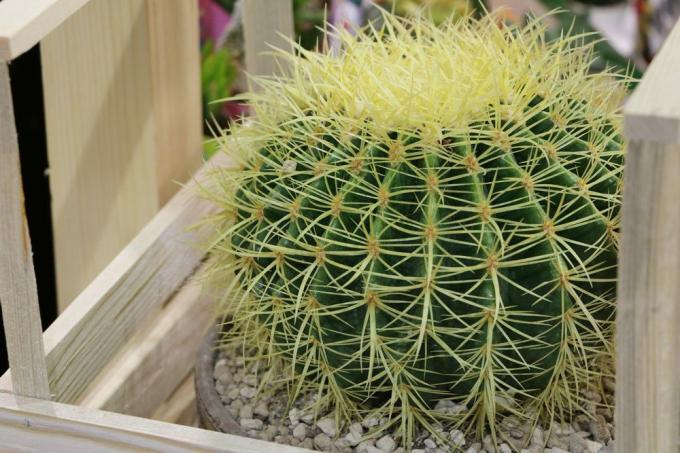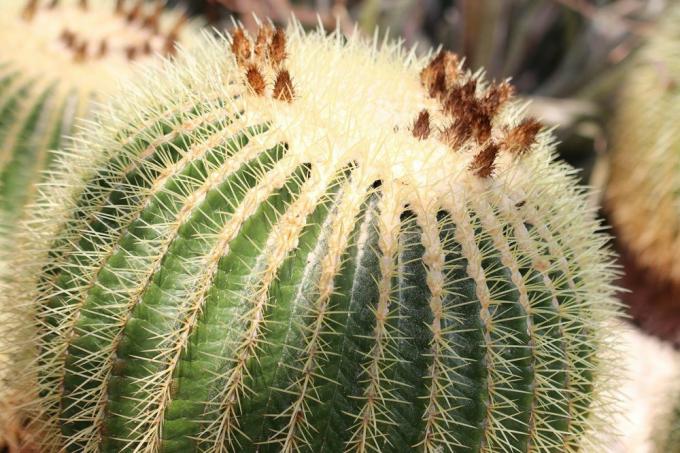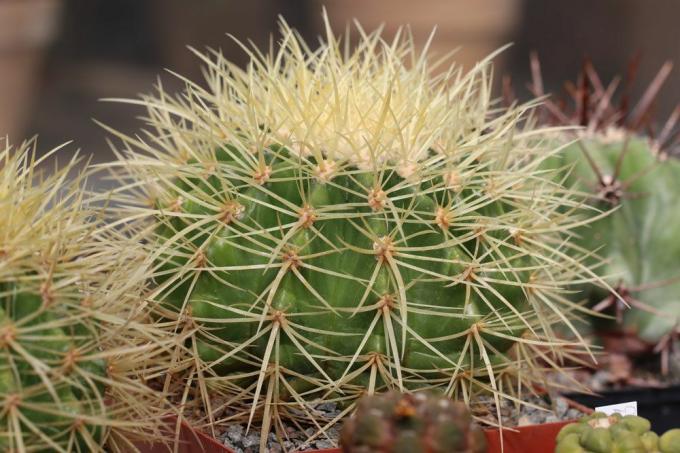
table of contents
- Location
- Substrate
- care
- to water
- Fertilize
- Repot
- Overwinter
- Multiply
- Diseases
- Pests
Profile and care information open +conclude -
- Flower color
- yellow white
- Location
- Partial shade, shady, sunny
- Heyday
- March, April, May, June, July, August, September, October
- Growth habit
- upright, bushy, perennial
- height
- up to 20 centimeters high
- Soil type
- stony, sandy, loamy, gravelly
- Soil moisture
- very dry, moderately moist
- PH value
- neutral, slightly acidic, acidic
- Limescale tolerance
- Calcium intolerant
- humus
- low in humus
- Poisonous
- no
- Plant families
- Cactus family, Cactaceae
- Plant species
- Container plants, rock garden plants, house plants, ornamental plants
- Garden style
- Pot garden, rock garden, gravel garden, ornamental garden
The golden ball cactus (Echinocactus grusonii), due to its growth shape, which is quite similar to seating furniture, and the long, sharp ones Spines, nicknamed the “mother-in-law's chair”, is probably one of the most popular in room culture Cacti. In fact, the species is easy to care for and can also grow very old and large. Over the years, the rapidly growing gold ball cactus develops an imposing size. The yellow flowers only appear on specimens from an age of around 20 years.
Location
The imposing gold ball cactus feels most comfortable at a temperature of warm 21 ° C and a sunny Location, which, however, has to be shaded in the blazing midday sun, especially in the case of younger specimens. The younger the mother-in-law chair is, the more sensitive it is to intense solar radiation, but it nonetheless needs a bright spot directly behind a window. This should be oriented to the south, south-west or south-east if possible.

- Ideal temperature between 19 and 24 ° C
- directly on a south-facing window
- a maximum of one meter from a window
- Shading in the blazing midday sun
Those who cannot meet these ideal conditions do not have to do without a gold ball cactus. This type of cactus also thrives in cooler locations in the light penumbra, but then grows more columnar than spherical. In addition, the beautiful gold color of the thorns is only evident when there is sufficient sunlight.
Put mother-in-law's chair outside in summer
If it is warm and sunny enough outside, place the golden ball cactus on the balcony, terrace or even inside during the summer months the garden - with its pot, of course, so that you can bring it back into the house in the event of heavy rain or sudden cold can. The plant does not belong directly in the sun, but has to be accustomed to it slowly for a few days. Otherwise there is a risk of burns, as the cactus that is otherwise cultivated in the room cannot tolerate the unfiltered rays of the sun. So first place it in the light penumbra and increase the light intensity from day to day. Bring the plants back into the house as soon as the temperatures drop below 10 ° C at night or the summer is unusually cold and rainy.
Substrate
Like all cacti, the mother-in-law chair is very sensitive to moisture. Therefore, the plant substrate must be well permeable so that excess irrigation water can drain off quickly. Use commercially available cactus soil or, if you want to mix the substrate yourself, a mix of one part each of potting soil, sand or gravel as well as clay granules, expanded clay or perlite. Only use plant pots with drainage holes on the bottom of the pot. A few potsherds are placed over these to prevent them from becoming silted up with potting soil and thus preventing a seal. A drainage layer a few centimeters thick made of expanded clay or small pebbles also prevents waterlogging.

care
The optimal care for the mother-in-law chair
Contrary to popular belief, cacti are not necessarily easy to care for, on the contrary, in fact. Some cactus species are quite capricious and require precise knowledge of temperature, humidity and light intensity. Not so with the gold ball cactus, because it is considered to be extremely uncomplicated. Even absolute beginners will enjoy this rapidly growing plant. You don't need any special showcases, plant lamps or similar equipment: just place the Mother-in-law's chair just close to a bright window and adhere to the following Care instructions.
to water
During the warm summer months, the gold ball cactus tolerates a penetrating watering, during which the substrate is vigorously soaked. After watering, wait a few minutes and remove the water that has run into the saucer or planter. This is important because the plant shouldn't have wet feet - permanent moisture will cause root rot and thus death of the cactus. Wait with the next watering until the substrate is completely dry. Don't be fooled: even if the surface appears dry, the potting soil deep inside can still be sufficiently moist. Always do a finger test or use a moisture meter.
autumn
From September you should gradually reduce the amount of water you give and water less and less. This serves to prepare for winter, because during the cold months between October and February the gold ball cactus is ideally not watered at all or only watered in droplets. However, this only applies if the plant hibernates cool. If, on the other hand, it remains in the warm living room, it will need some water once a month - but not much, a good sip is enough.
spring
Gradually increase the watering rate from March until you return to the regular rhythm. Whether summer or winter: Only use rainwater or stale water for watering, because the mother-in-law chair does not tolerate lime. In addition, the irrigation water should be room temperature: After all, you don't have an ice cold shower, right?

Fertilize
Also between May and September you fertilize the golden ball cactus once a month. Ideally, the nutrients are supplied with liquid cactus fertilizer, which you add to the irrigation water. As a result, the nutrients reach the roots faster and the plant can absorb them better. If you have repotted your specimen in fresh substrate in the spring, you do not need to fertilize at all for two to three months. After that, a supply of half the concentration specified by the manufacturer on the packaging is sufficient.
Repot
Occasionally you can read that the mother-in-law chair should be repotted once a year due to its rapid growth. However, the right time for moving to a new container cannot be determined in such a general way: Instead lift the cactus (caution: use gloves or a terry towel!) out of the pot and examine it Root system. Repotting is only necessary when the root ball is well rooted and the individual roots are already growing out of the pot. Choose a larger pot, but it shouldn't be too big: In oversized planters, more moisture collects and thus promotes rot. The pot is a good size when its diameter is about one and a half times that of the root ball.
Carry out repotting as follows:
- best possible time: spring after winter rest (approx. March to April)
- Thoroughly clean & disinfect the new plant pot (if used)
- Fill in a drainage layer made of pebbles or expanded clay
- Fill in the substrate up to halfway
- Get the cactus out of the old pot (only with sturdy gloves or similar). ä.!)
- Carefully remove old substrate
- Examine the roots carefully
- Cut off sick, dead and torn roots
- Hold the root ball in the new plant pot
- Fill in substrate
- several times carefully with the bottom of the pot on the table or similar. ä. beat
- this will fill any air holes
- Carefully press the substrate
- Water the cactus

Washing out the planter is important because it removes any pathogens that may have stuck to it. Also clean the pot if you continue to use the old one and only replace or replace the substrate. fill up.
Cut
The gold ball cactus must not and cannot be pruned in any way at any time. This type of cactus forms only a few offshoots very rarely and only at an advanced age. The only time you might be able to use the scissors is during the annual repotting. Here, sick, torn off and dead roots should be pruned.
Overwinter
In the Mexican home of the gold ball cactus there is no winter with frost and possibly Snow like in Central Europe, but nature pauses for a few months when it is cooler Temperatures. For this reason, it makes sense to keep the mother-in-law's chair cooler between October and March, even in indoor culture, to drastically reduce watering and to stop fertilizing.
During the winter months, a bright place and temperatures between five and ten degrees Celsius are ideal. You have this, for example, in an (unheated) bedroom, in a bright stairwell or in an unheated winter garden. Under no circumstances should you expose the plant to frost, which is why you should - if it is an im Free summered specimen trades - back into the house in good time before the first night frosts to fetch.
Multiply
Since the mother-in-law chair has no or If children or offshoots only develop at an advanced age, propagation only takes place via sowing. With a little luck (and a correspondingly older specimen) you can even get the seeds you need Harvest yourself: After flowering, the cactus forms fruits that are around two centimeters long and contain the seeds contain. But you can also buy them in well-stocked specialist shops.
Sowing is done in this way:
- Fill shallow dishes with potting soil
- slightly moisten them (ideally with a warm spray mist)
- Spread the seeds, press down lightly
- do not cover with earth, gold ball cactus is a light germ
- Cover the bowl with translucent foil
- Place the bowl in a light and about 25 ° C warm place
- bright, but no direct sunlight
- Ventilate daily and keep slightly damp

The seeds germinate within a few days and must be pricked out early if they are too dense. This means that you separate the small plants with the help of a wooden stick. After a few weeks, plant the young cacti individually in small pots and care for them in the same way as adult specimens.
Diseases
Root rot
Waterlogging is particularly problematic, as this inevitably leads to root rot. The cause is always too much moisture, either from a permanently moist plant substrate and / or from water standing in the saucer or planter. To prevent root rot, you should always clean the cactus thoroughly between watering Let it dry out and, above all, immediately remove the watering water from the saucer or from the planter remove. The overwatering can be clearly recognized by the sickly, yellowish discoloration of the specimen in question. Also, due to the rot, the cactus will become soft. There are no countermeasures.
Fusarium wilt, Phytophthora rot, falling sickness
However, incorrect watering does not always have to be the cause of rot. Some viruses, bacteria or fungi (which, for example, get to the cactus with the irrigation water or the plant substrate) can be the cause. The golden ball cactus is seldom afflicted by the Fusarium wilt, the Phytophthora rot or the so-called falling sickness. These diseases are highly contagious and endanger the rest of your indoor plant population. For this reason, you should immediately dispose of the diseased cactus with the household waste - there is no rescue.
Notes on further care errors:
- Cactus grows cylindrical instead of spherical: lack of light
- Cactus turns slightly purple or reddish in color: direct sunlight is not tolerated
- Cactus looks puffed up or bloated: overfertilization
Powdery mildew rarely occurs
If the gold ball cactus is covered with a white, powdery and wipeable layer, this can have various causes. In most cases it is caused by pests such as mealybugs or spider mites, but sometimes it can be also be an infection with powdery mildew, a very common in house and cultivated plants Fungal disease. This disease can usually be treated very well with a whole milk-water mixture, which is sprayed several times on the affected plant. The golden ball cactus does not tolerate this treatment, and it is not possible to cut away the infected areas. Instead, separate the cactus in question from any other plants that may be present - in this way you avoid infection - and dust it with rock flour.
Pests
As with any other plant, gold ball cacti are also attacked by pests. Particularly common in specimens cultivated in apartments or winter gardens are aphids, woolly or Mealybugs and spider mites. Infested plants should be separated as soon as possible to prevent them from spreading to other plants. With good, species-appropriate care, an infestation can be prevented to a certain extent, because pests prefer to settle on rather sickly and therefore weak plants.

Aphids
These sap-sucking pests are often discovered late: the tiny black, brown or green plant lice are hardly noticeable as dark spots on the cactus. If the infestation is already advanced, the animals attract attention because of their sheer size - or because of the smeary, black layer that suddenly appears on the surface of the cactus spread. This is the sooty fungus that is found on the sweet excretions of aphids, known as "honeydew". The pests can be removed by showering with a powerful jet of water or by repeatedly spraying tansy or nettle tea. Make sure that the substrate is not soaked (for example by putting a plastic bag over it) and that the cactus dries off quickly.
Mealybugs or mealybugs
Wool or Mealybugs are also sap-sucking pests. In the adult stage, the tiny insects sit under a hard, white cocoon that protects them from predators. In the advanced stage, a greasy, sticky film forms that also drips down from the plant. Rapeseed oil-based insecticides provide a remedy.
Spider mites
Spider mites are not insects, but arachnids and as such weave fine white webs between the spines of the golden ball cactus. Here, too, preparations based on rapeseed oil drive away unwanted visitors.



